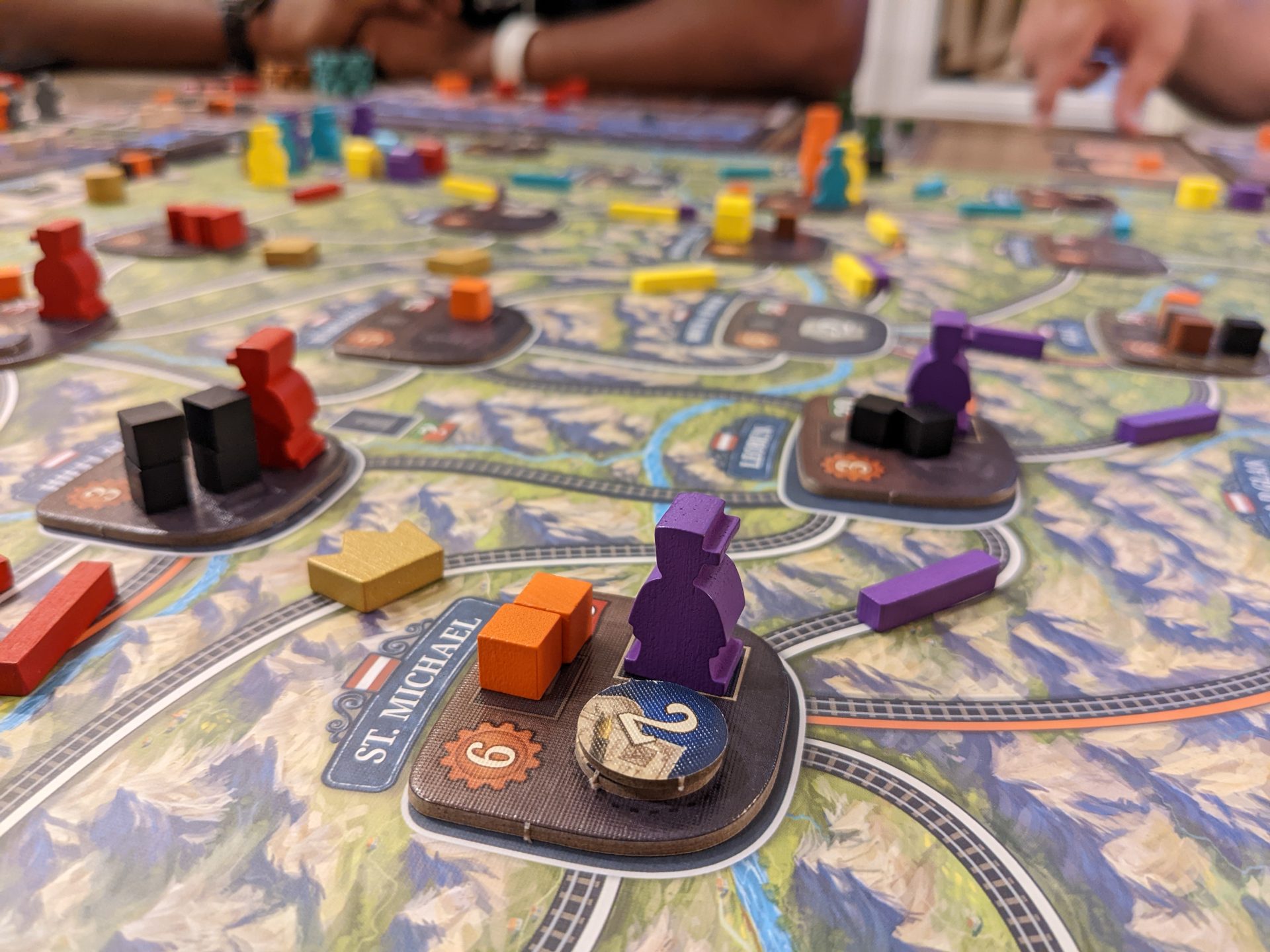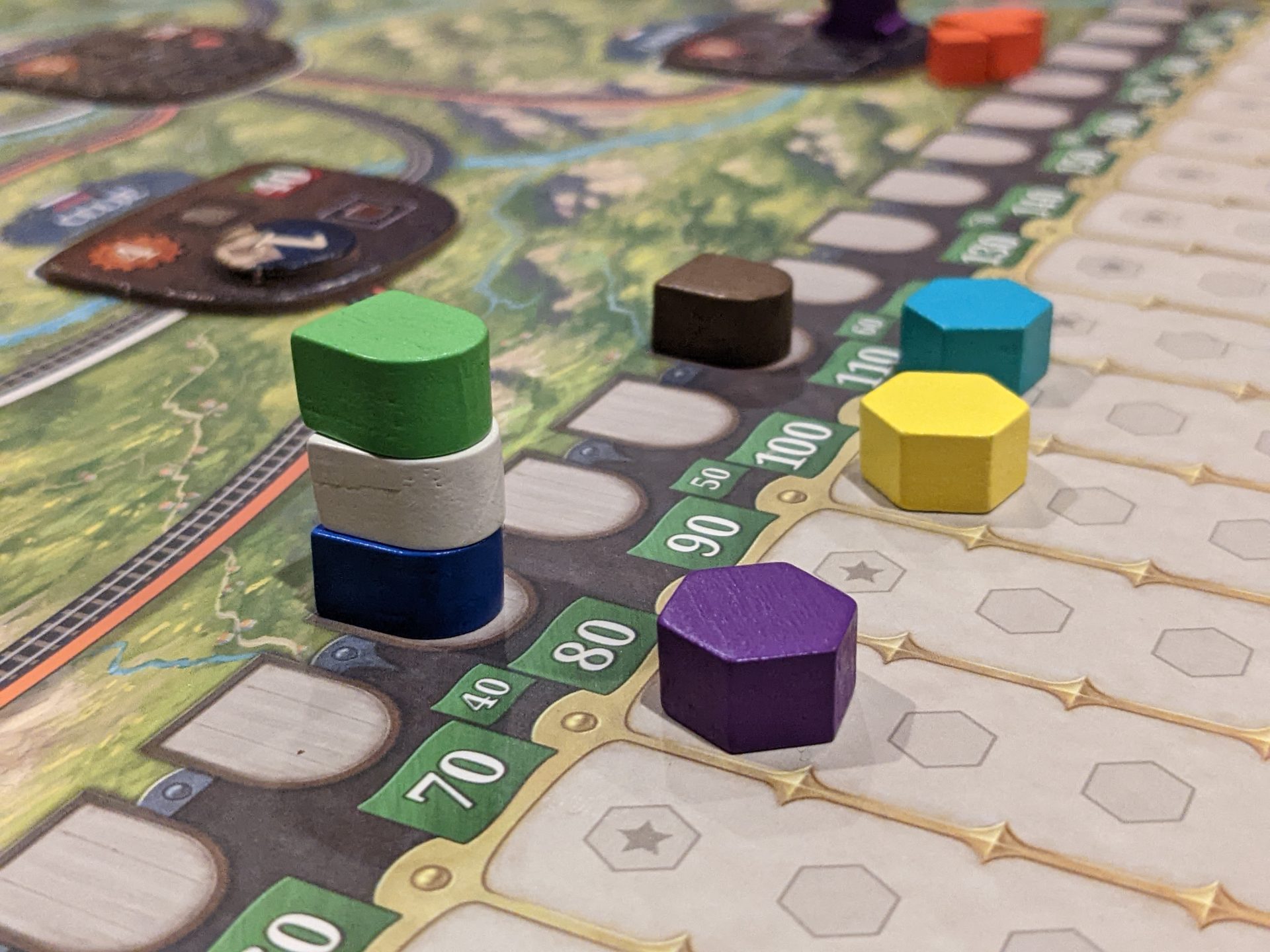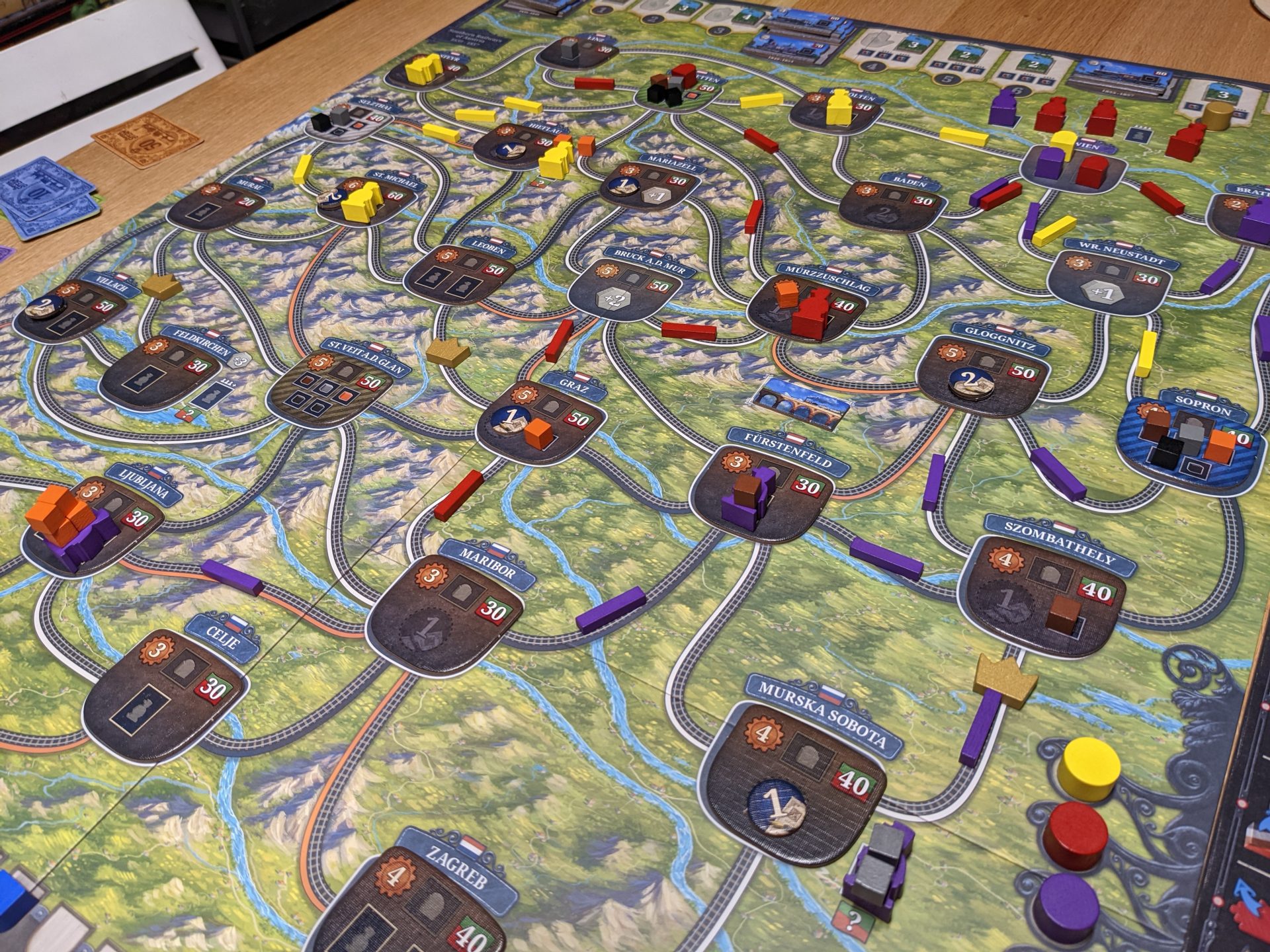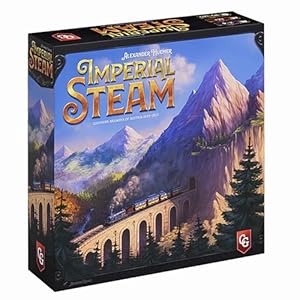Disclosure: Meeple Mountain received a free copy of this product in exchange for an honest, unbiased review. This review is not intended to be an endorsement.
It was over.
3 hours and 15 minutes after it began, my first 4-player game of Imperial Steam (Capstone Games, 2021) had left its mark on the world. It also left my buddy Johnivan hunched backwards in his chair, exhausted from the experience.
It was his second time playing. “What did you think, this time around?” I asked.
“It’s a lot,” he offered, wearily. “But I love it.”
That seems to be the takeaway from everyone I have joined for a play of Imperial Steam. It’s a big piece of chicken, but everyone seems to like the taste. Me? There’s a lot to love, but I openly wonder: how different will that piece of chicken be after the 10th play?

Train games just didn’t have enough going on
Between a 48-minute teach video and a 30-page rulebook, Imperial Steam feels like a Capstone Games game right away.
Heavy. Real heavy. Heavier than Ark Nova. Heavier than Crystal Palace. About as heavy as the older games that Capstone now distributes in the US, like Terra Mystica and Gaia Project. Just as heavy as Clinic: Deluxe Edition.
All this is to say: if you see the Capstone logo on the side of the box, buckle up. Serious Strategy Gamers Only, the logo seems to say.
Covering the rules of Imperial Steam here would be ridiculous. In fact, it might take up more white space than my editors really want to see. Just know this much: set aside at least an hour to teach this game to a heavy strategy gamer, maybe longer for those who are newer to games with these systems.
Imperial Steam is a worker placement economic game featuring players starting up a railroad business in Austria, 1839. (And yes, it is a “train game”, because there ARE trains, you are building tracks, and you are running a railroad business. Train game, end of story!)
Over the course of 5-8 rounds—the number of rounds is not set, thanks to the end-game trigger—players will take 2-5 actions per round doing many of the things you might do in an 18XX game, while managing a limited number of actions to expand your network from northern Austria to the city of Trieste.
Your goal in Imperial Steam: make the most money.

In an 18XX game, you’d have stock rounds, as players invest in their own plus other players’ railways to make the most money. In Imperial Steam you’ll only bet on yourself, by transporting goods to hub cities all over the map, gaining influence in the affairs of the game world, fulfilling contracts by building factories and producing goods, and laying track all over the map.
If you ever felt like 18XX was too “big picture” for you, don’t worry—Imperial Steam goes a layer deeper, by adding open worker placement spots to gameplay. (By “open”, I mean that spots cannot be blocked by other players; everyone has access to the same 11 actions in the game.) It also asks players to manage smaller amounts of money, money which is used to pay wages for workers, or for goods used to build train tracks across three different types of terrain.
More, you say? Imperial Steam also limits the number of places where factories can be built—in this game, a factory is defined as a worker which has been turned into a coal, stone, wood or iron factory permanently. (Similar to Dwellings of Eldervale, those workers go to die in the service of their in-game country.) Factories can produce goods, but goods can also be bought on layaway at the open market, with goods that arrive in the following round.
Normally, this is the part of a review where you would ask me about money.

How Tight is Money in Imperial Steam?
This is maybe the hardest question to answer about the game. Another Capstone Games release, Pipeline, is maybe the tightest I have ever seen with regards to in-game money. You don’t start with enough, you take loans that also don’t feel like enough, and everything costs a little too much.
So, I won’t dodge your question but I will answer this in two parts.
First: money is tight in Imperial Steam, especially in rounds 1 and 2. It feels almost impossibly tight, especially if your game’s variable setup places too many of the hub cities quite high on the influence track, or if you get hosed and have to buy workers and can’t get enough of them (without enough workers, you can’t build enough track to move around the map).
In each of my plays leading up to this review, someone has openly joked with the exact same line: “How do you make money in this game again?”, and that usually happens during round 2, when you have three actions, basically no money, and you take an action to get a measly 10 guldens (the monetary unit here) only to turn that money into a single good.
Second: money is suddenly not tight if you have planned well enough to deliver a couple of goods early in the game, then can buy enough workers to turn them into production huts that allow you to kickstart your goods loop. That feels pretty good, especially if you can stave off selling a share (eliminating 10% of your end-game score) to get a financial boost.
Sometime in, say, round 2 or 3, at least one player will have a little money, a little scratch. If that player is you, you will probably celebrate (inside, at least) the fact that you were the first to win that race. You might not capitalize—and that was me on my last play of Imperial Steam—but you’ll feel like a genius for a few minutes, and that’s why you play games, right?

Most Things Work
The last time I set up Imperial Steam, I used the Random Setup Variant, and I immediately decided that no other game I own has this much variety in its initial board setup.
The hubs can be in 4 of 12 different spots on the map. The influence tokens can start with a pretty wide range, and that sets the market for which worker hubs start where. The State Railways, which offer players the chance to own routes that have to be bought into at higher rates than normal routes, can be in, like, 30 different places.
The number of goods available for layaway each round varies. The spots where goods can be delivered varies. The contracts that come out vary too. Every game tells you that the game can be totally different each play, but at least during the setup, Imperial Steam really checks this box. (This also means Imperial Steam is a nightmare to set up.)
The production is a B+. You won’t have Kanban EV or Rococo Deluxe vibes; Eagle-Gryphon Games’ deluxe productions are not on display here. But Imperial Steam is not far behind EGG-level production values, with solid player boards, lots of easy iconography, and a well-written (and not overwritten) rulebook. Everything is laid out well, which gives you a chance to plan your strategy in what comes down to a zero-luck experience.
My third play of this game (3 players, although admittedly with 3 players who had all played before) took just under 2 hours. That’s incredible, when considering the weight of each decision in Imperial Steam. My fourth play—with the same 3 players—also took about 2 hours. I could easily see this getting to 90 minutes by my fifth or sixth play, assuming I’m playing with the same experienced players.

Some Things Don’t Work
Imperial Steam will have the same problem Food Chain Magnate has with experienced players surrounding a newbie: I could see new players normally getting blown off the table without some help, and poor decisions early in Imperial Steam will cost you the game. I am undecided on whether this is a feature or a bug, because I prefer games that give smart players a chance no matter how experienced the competition is.
So much of what happens in Imperial Steam comes down to knowing the balance of the production loop, and finding the best ways to get to Trieste; I think seeing these strategies are nearly impossible during a first play.
Three of my four games have been won by the player who made it to Trieste first; I haven’t played a game yet where multiple players made it. I lost my last game to a player who won by about 40 guldens, which means I lost because he scored the Trieste bonus (tied to getting 10 guldens for each link of track to get from the start of the map to the finish line).
That, to me, means the game should just end as soon as someone gets to Trieste. Although I’m sure some of you have won by not going to Trieste, I’m guessing if we laid out a sample set of 100 plays, the winner 90% of the time or more went to Trieste and got there first.
This leads to what might not work in Imperial Steam: the game feels a little scripted at the start (the rules literally tell players to buy workers with one of your first two actions) and at the end (you have to go to Trieste in order to be in the running for the win, and almost all players buy their way into the top slots on the influence track to qualify for a 100-gulden bonus).
Doesn’t this mean that the rules should just start players with less money and more workers?

Initial actions in rounds 1 and 2 have generally looked the same: across your first five actions, you are likely going to buy workers then build track (everyone is given the resources needed to build track to start the game), then turn a worker into a factory, take a 10-gulden loan, and buy goods, with ideally a hub connection allowing for the sale of a single good by the end of round 2.
The order will look different from game to game, but the intent is the same. Again, I’m not sure if this is a feature or a flaw, but it is worth mentioning.
Having only one map hurts a little bit too; I’m already hoping for a double-sided board with expansion maps to come down the pipe soon. I’m also down with more hub tiles that shake things up a bit: maybe some that have more influence tokens, or some tiles that have 1-2 spots for good deliveries to inject more cash into the engine.

It’s Really Good
Imperial Steam adds things that I didn’t think games this heavy needed, but to its credit, the game’s systems mostly work well together.
It’s punishing, but a good teaching tool for multiple plays. That automatically creates both an opportunity and a problem: similar to games like Oath, you will want to find a few friends committed to playing this a dozen times. That will squeeze out bringing this to the table with experienced players and, like, one newbie, because teaching this game to anyone will require a Herculean effort.
Imperial Steam is certainly interactive, whereas some of these dry economic Euros don’t quite get there for me; getting boxed out is very real, particularly when the same players are competing for the same hub city locations. I despise Food Chain Magnate because games can kill off another player early then leave them with nothing to do for 3 hours. In Imperial Steam, getting boxed out still leaves you with things to do, even as your win probability slowly slides to zero.
I’m enjoying what I have, but to keep things fresh, a map that features multiple city end points or a smaller overall footprint would be really interesting; the “Imperial Steam System” (one of the players in my review group coined this, so I will give credit where credit is due!) is now ready for bigger britches. Mix that with another hub city, and some more city tiles that spike the cash engine, and we are almost all the way there.
Imperial Steam is quite good. I’m looking forward to scratching that heavy strategy game itch again soon!












Great review I agree with most of it, it isn’t for everyone but most heavy gamers will enjoy it I think. That has been my experience when I have introduced it to people. Such a great game, I would rather play this than Brass!